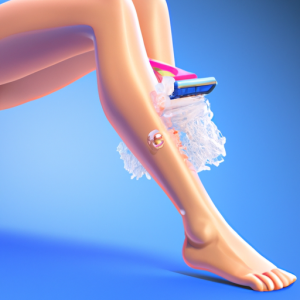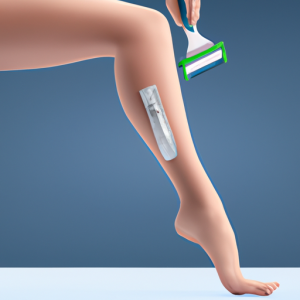Understanding Ulike Hair Removal: What You Need to Know is an informative guide to help you understand the basics of Ulike Hair Removal. This guide covers the types of hair removal, the benefits of Ulike Hair Removal, and the potential risks associated with the procedure. We’ll also discuss the costs of Ulike Hair Removal and how to prepare for the procedure. With this guide, you’ll be well-informed and ready to make an informed decision about whether Ulike Hair Removal is right for you.

Different Types of Hair Removal
Hair removal is a common practice for many people, and there are a variety of methods available to achieve the desired results. Depending on the individual’s needs, budget, and preferences, one method may be more suitable than another. Here are some of the most popular types of hair removal:
Shaving: Shaving is the most common and least expensive form of hair removal. It involves using a razor to cut the hair at the surface of the skin. It is fast and easy, but the results are only temporary, as the hair will grow back quickly.
Waxing: Waxing is a popular method of hair removal that involves applying a warm wax to the skin and then quickly removing it, along with the hair. It is more effective than shaving, as it removes the hair from the root, and the results can last for several weeks.
Depilatory Creams: Depilatory creams are chemical-based creams that dissolve the hair at the surface of the skin. They are relatively inexpensive and easy to use, but they can be irritating to the skin and may not be suitable for those with sensitive skin.
Laser Hair Removal: Laser hair removal is a more permanent form of hair removal that uses laser energy to destroy the hair follicles. It is more expensive than other methods, but the results can last for several years.
Electrolysis: Electrolysis is a more permanent form of hair removal that uses electrical currents to destroy the hair follicles. It is more expensive than other methods, but the results can last for several years.
Threading: Threading is a method of hair removal that involves using a thin thread to remove the hair from the root. It is relatively inexpensive and can be done at home, but it can be time-consuming and the results may not last as long as other methods.
Tweezing: Tweezing is a method of hair removal that involves using tweezers to pluck the hair from the root. It is relatively inexpensive and can be done at home, but it can be time-consuming and the results may not last as long as other methods.
No matter which method of hair removal you choose, it is important to follow the instructions carefully and take precautions to protect your skin. Be sure to use products that are specifically designed for hair removal, and always test a small area of skin before using a product on a larger area.

Benefits of Hair Removal
Hair removal is a process of removing unwanted hair from the body. It is a common practice that has been around for centuries, with many different methods being used throughout the years. While it may seem like a relatively simple process, there are actually a number of benefits to hair removal that make it an attractive option for many people.
One of the primary benefits of hair removal is the aesthetic appeal it provides. Removing unwanted hair can help improve the appearance of the skin, making it look smoother and more even. This can be especially beneficial for those who have dark, coarse hair that is difficult to hide. Removing the hair can also help to reduce the appearance of ingrown hairs, which can be unsightly and uncomfortable.
Hair removal can also help to reduce the risk of skin irritation and infection. When hair is left on the skin, it can trap dirt and bacteria, leading to irritation and infection. Removing the hair can help to reduce the risk of this occurring. Additionally, hair removal can help to reduce the risk of razor burn and other skin irritations that can occur when shaving.
Hair removal can also be beneficial for those who are prone to excessive sweating. Removing the hair can help to reduce the amount of sweat that is produced, which can help to reduce body odor and keep the skin feeling more comfortable.
Finally, hair removal can help to reduce the amount of time it takes to get ready in the morning. Without the need to shave or wax, you can save time and effort, allowing you to get ready faster and get on with your day.
Overall, hair removal can provide a number of benefits, from improved aesthetics to reduced skin irritation and infection. Whether you are looking to improve your appearance or simply save time in the morning, hair removal can be a great option.

Risks of Hair Removal
Hair removal is a common practice for many people, but it is important to be aware of the risks associated with it. While it is generally considered safe, there are potential risks that should be taken into consideration before undergoing any hair removal procedure.
The most common risk associated with hair removal is skin irritation. This can range from mild redness and swelling to more serious reactions such as burning, blistering, and scarring. In some cases, the skin may become infected due to bacteria or other pathogens entering the skin through the hair follicles.
Another risk associated with hair removal is the potential for skin discoloration. This can occur when the hair removal product is not applied correctly or when the wrong type of product is used. In some cases, the skin may become darker or lighter than its original color.
Hair removal can also cause temporary hair loss. This is usually due to the trauma caused by the procedure and can last anywhere from a few days to a few weeks. In some cases, the hair may not grow back at all.
Finally, there is the risk of permanent hair loss. This is a rare occurrence, but it can occur if the hair follicles are damaged during the procedure. This can lead to baldness or patchy hair loss.
Overall, hair removal is generally considered safe, but it is important to be aware of the potential risks associated with it. It is best to consult with a qualified professional before undergoing any hair removal procedure to ensure that it is done safely and effectively.
How to Choose the Right Hair Removal Method
When it comes to hair removal, there are a variety of methods available to choose from. From waxing to laser hair removal, each method has its own pros and cons, so it’s important to do your research before deciding which one is right for you. Here are some tips to help you choose the right hair removal method for you.
First, consider your budget. Hair removal can be expensive, so it’s important to consider how much you’re willing to spend. Some methods, such as laser hair removal, can be quite costly, while others, such as waxing, are more affordable.
Second, consider the area you want to treat. Different methods are better suited for different areas of the body. For example, waxing is best for larger areas, such as the legs, while laser hair removal is better for smaller, more sensitive areas, such as the face.
Third, consider the amount of time you’re willing to commit to the process. Some methods, such as waxing, require regular maintenance, while others, such as laser hair removal, are more permanent.
Fourth, consider the level of pain you’re willing to endure. Some methods, such as waxing, can be quite painful, while others, such as laser hair removal, are relatively painless.
Finally, consider the long-term effects of the method. Some methods, such as waxing, can cause skin irritation and ingrown hairs, while others, such as laser hair removal, can cause permanent hair loss.
By considering these factors, you can make an informed decision about which hair removal method is right for you. With the right method, you can achieve the smooth, hair-free skin you desire.
Aftercare Tips for Hair Removal
Hair removal is a common practice for many people, and it can be done in a variety of ways. However, regardless of the method used, it is important to follow proper aftercare tips to ensure the best results and minimize any potential risks. Here are some tips to help you get the most out of your hair removal treatment.
1. Avoid Sun Exposure: After hair removal, your skin will be more sensitive to the sun’s rays. To avoid any potential skin damage, it is important to avoid direct sun exposure for at least 24 hours after the treatment. If you must go outside, make sure to wear sunscreen with an SPF of at least 30.
2. Avoid Hot Showers: Hot water can irritate the skin and cause further irritation after hair removal. It is best to take a cool or lukewarm shower instead.
3. Avoid Exfoliating: Exfoliating the skin can be beneficial for some skin types, but it should be avoided after hair removal. Exfoliating can irritate the skin and cause further inflammation.
4. Avoid Tight Clothing: Tight clothing can rub against the skin and cause further irritation. It is best to wear loose-fitting clothing that does not rub against the skin.
5. Apply a Cool Compress: Applying a cool compress to the area can help reduce inflammation and soothe the skin.
6. Moisturize: Moisturizing the skin can help keep it hydrated and reduce any potential irritation.
7. Avoid Perfumes and Fragrances: Perfumes and fragrances can irritate the skin and cause further inflammation. It is best to avoid them for at least 24 hours after the treatment.
8. Avoid Exercise: Exercise can cause sweat to accumulate on the skin, which can irritate the area and cause further inflammation. It is best to avoid any strenuous activity for at least 24 hours after the treatment.
Following these aftercare tips can help you get the most out of your hair removal treatment and minimize any potential risks. If you have any questions or concerns, it is best to consult with a professional to ensure the best results.
Understanding Ulike Hair Removal is an important part of taking care of your body. With the right knowledge and the right tools, you can safely and effectively remove unwanted hair. Ulike Hair Removal offers a variety of options, from waxing and threading to laser and electrolysis. With a bit of research and the right technique, you can find the best method for you and your skin type. With Ulike Hair Removal, you can feel confident in your appearance and enjoy smooth, hair-free skin.





